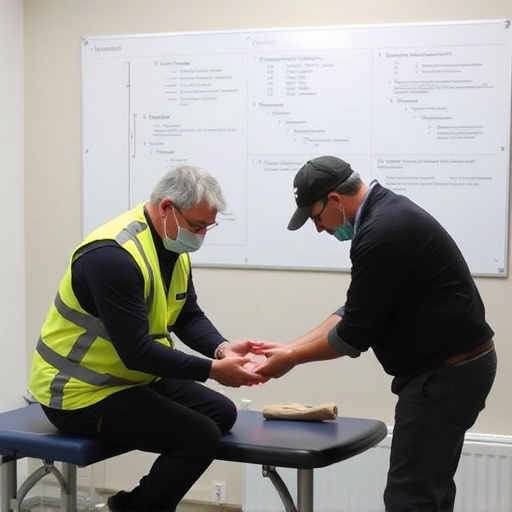Repetitive Strain Injury (RSI) prevention focuses on ergonomic workplace adjustments, regular breaks, and stretching. Triggers like static postures, repetitive motions, and inadequate equipment cause RSI symptoms like pain in wrists, hands, neck, and back. Ergonomic practices, including chair adjustments, desk organization, and specialized accessories, significantly reduce RSI risks by promoting neutral spinal alignment and proper posture. Short breaks and targeted stretches every 30-60 minutes alleviate muscle tension and fatigue, further minimizing RSI risk.
Repetitive strain injuries (RSIs) are a common workplace hazard, affecting millions globally. This guide aims to empower workers with strategies to prevent these debilitating conditions. We’ll explore key triggers for RSIs and provide actionable tips for creating an ergonomic workspace. Additionally, we delve into the importance of regular breaks and stretching techniques to promote comfort and reduce risk. By implementing these measures, you can significantly lower your chances of developing a repetitive strain injury at work.
- Understand Repetitive Strain Injury Triggers
- Ergonomic Setup for Workplace Comfort
- Regular Breaks and Stretching Techniques
Understand Repetitive Strain Injury Triggers

Repetitive Strain Injury (RSI) is a common condition affecting many individuals, especially those with desk jobs or repetitive tasks. To prevent RSI, it’s crucial to understand what triggers it. Common factors include performing the same motion repeatedly, holding positions for extended periods, and using improper posture or techniques. For example, prolonged typing without breaks or incorrect mouse usage can lead to wrist and hand pain. Even something as simple as cradling a phone between your ear and shoulder for hours can contribute to RSI.
Recognizing specific activities or postures that cause discomfort or pain is the first step in prevention. If you experience lower back pain, neck stiffness, or carpal tunnel-like symptoms, take notice. These could be early signs of RSI. While some cases may require medical interventions like spinal adjustment or shockwave therapy, making adjustments to your work setup and habits can go a long way. Regular breaks, ergonomic equipment, and varied tasks throughout the day can help mitigate these risks.
Ergonomic Setup for Workplace Comfort

Setting up your workspace ergonomically is a powerful way to prevent repetitive strain injuries (RSIs). It involves arranging your workstation and tools to promote comfortable and natural positions for your body. Start with adjusting your chair; ensure it provides adequate lumbar support, and its height allows your feet to rest flat on the floor while keeping your knees level with or slightly lower than your hips. This neutral posture reduces stress on your back and promotes good blood flow.
Next, consider your desk setup. Keep frequently used items within easy reach to avoid straining your arms and neck. Use a document holder to keep papers at eye level, reducing the need for constant neck flexion. Additionally, invest in an ergonomic keyboard and mouse to support your wrists in neutral positions, which can significantly reduce the risk of carpal tunnel syndrome and other soft tissue injuries. Remember, these adjustments are crucial for chronic pain management and can even provide sciatica relief by maintaining proper alignment and posture throughout your work day.
Regular Breaks and Stretching Techniques

Taking regular breaks and incorporating stretching techniques into your workday is a powerful strategy to prevent a repetitive strain injury (RSI). Prolonged periods of immobility or repetitive tasks can lead to muscle tension, fatigue, and chronic pain management issues over time. By scheduling short breaks every 30-60 minutes, you allow your muscles to relax, improve blood circulation, and reduce the risk of developing musculoskeletal injuries.
During these breaks, simple stretching exercises can make a significant difference. For example, shoulder rolls, wrist extensions, and neck tilts can help alleviate tension in the upper body. Targeting different muscle groups with specific stretches ensures comprehensive chronic pain management and reduces the chances of RSI. Additionally, spinal adjustments, when performed by a qualified professional, can further enhance flexibility and overall musculoskeletal health.
Preventing a repetitive strain injury (RSI) at work starts with understanding its triggers, implementing ergonomic solutions, and incorporating regular breaks with stretching techniques. By adopting these measures, you can create a comfortable workplace environment, reduce stress on your body, and minimize the risk of developing RSI. Remember, proactive steps today can protect your health tomorrow.














